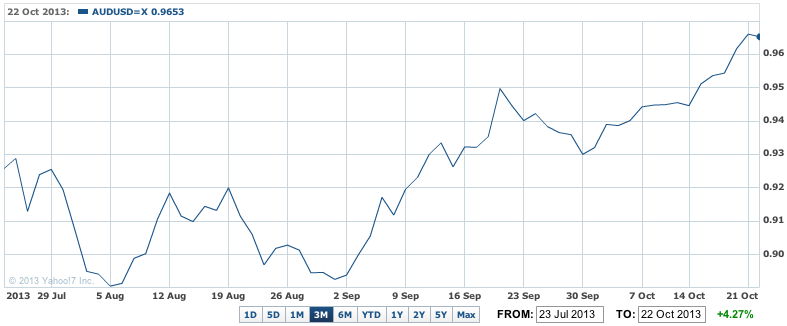A weak September jobs report finally struggled into the markets overnight and the 148,000 new jobs created failed to convince anyone, so up went markets, with Wall Street up more than half a per cent at the close.
The jobs data didn’t reflect the impact of the US government shutdown – that will come in the October report which is out November 8.
The Standard & Poor’s 500 rose past 1,750 for the first time ever overnight and ended with a 0.6% rise to 1,754.67.
Gold rose 2%, the Aussie dollar topped the 97 US cent level and is on its way to parity in coming months unless there’s a circuit breaker.
Weak US jobs report boosts markets and the Aussie dollar

Oil slipped further with US prices under $US98 a barrel and looking to go further, but the Brent price in London rose.
Markets in Europe ended with gains, while in Asia, only Japan, Singapore and Australia showed gains yesterday.
Our market is looking for another solid start today with the futures market showing a rise of more than points.
That means another day of new five year highs for the Aussie market.
Yesterday saw the ASX 200 up 21 points, or 0.4%, at 5373.1, and the All Ords rose 19.7 points to 5371.2, as BHP surged more than 2% and dragged the rest of the market higher.
It was the sixth successive day of gains and a seventh today is in prospect.
Consumer price inflation data out today will confirm that cost pressures remain benign.
And even though a small rise in the quarter is forecast, the annual rate will fall to under 2%.
US economists said the weak jobs report means the Fed (which meets next week), will keep their bond buying going until early 2014.
Besides the September figure of 148,000 new jobs there were revisions to July and August.
The change in total non-farm payroll employment for July was revised down, from 104,000 to just 89,000, and the change for August was revised up from 169,000 to 193,000.
With these revisions, employment gains in July and August combined were 9,000 more than previously reported, which didn’t impress anyone.
And monthly job creation in the US is easing: just 143,000 a month in the third quarter, after an average 207,000 jobs were created in the first quarter, and 182,000 were added in the second quarter.
That points to the Fed keeping its spending going for longer.
The US unemployment rate eased to 7.2% from 7.3% while the participation rate was steady. US unemployment has fallen by more than half a million people in the past year, but there has also been as many people, if not more, who have stopped looking for work.
US 10 year bond yields fell sharply to 2.53%, a three month low, a signal there’s a belief the US economy will be weaker for longer into the future than many people expect. Yields on UK and German bonds also fell sharply.













